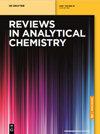Eco-friendly HPLC method by using response surface design to measure a combination of three antidiabetic drugs
IF 3.8
3区 化学
Q2 CHEMISTRY, ANALYTICAL
引用次数: 0
Abstract
Abstract In recent years, there has been a significant increase in the application of green chemistry principles in analytical chemistry. One of the key factors affecting the environmental sustainability of analytical methods is the choice of solvent. In this particular study, a two-factor, three-level response surface design was employed to develop an environmentally friendly chromatographic technique for a mixture of metformin, glimepiride, and pioglitazone. Ethanol, which is known to be harmless to the environment, was chosen as the organic modifier in the mobile phase. The separation of the mixture was achieved using a phosphate buffer solution (pH 3) mixed with ethanol (30:70 v/v). The linearity of the developed method covered a concentration of metformin of 10–120 µg·mL −1 with a correlation coefficient of 0.9998, glimepiride of 0.1–20 µg·mL −1 with a correlation coefficient of 0.9997, and pioglitazone of 1–50 µg·mL −1 with a correlation coefficient of 0.9999. To evaluate the environmental friendliness of the developed method, two assessment tools were employed: The Analytical GREEnness metric and Green Analytical Procedure Index. The results revealed that the developed method performed exceptionally well in terms of its eco-friendliness. Furthermore, the developed method was compared to other reported methods in terms of both accuracy and environmental sustainability. The results demonstrated that the developed method serves as an excellent alternative to well-established techniques for the separation and quantification of the analyzed mixture. Overall, this study highlights the importance of integrating green chemistry principles into analytical chemistry practices.采用响应面设计环保型高效液相色谱法测定三种降糖药的联合用量
近年来,绿色化学原理在分析化学中的应用有了显著的增加。影响分析方法环境可持续性的关键因素之一是溶剂的选择。在这项特殊的研究中,采用双因素,三水平响应面设计来开发一种环境友好的二甲双胍,格列美脲和吡格列酮混合物的色谱技术。在流动相中选择对环境无害的乙醇作为有机改性剂。使用磷酸盐缓冲溶液(pH 3)与乙醇(30:70 v/v)混合实现混合物的分离。二甲双胍浓度为10 ~ 120µg·mL−1,相关系数为0.9998;格列吡脲浓度为0.1 ~ 20µg·mL−1,相关系数为0.9997;吡格列酮浓度为1 ~ 50µg·mL−1,相关系数为0.9999。为了评估所开发方法的环境友好性,采用了两种评估工具:分析绿色度度量和绿色分析程序指数。结果表明,所开发的方法在其生态友好性方面表现得非常好。此外,在准确性和环境可持续性方面,将开发的方法与其他报道的方法进行了比较。结果表明,所开发的方法是一个很好的替代既定的技术分离和定量分析的混合物。总的来说,本研究强调了将绿色化学原理整合到分析化学实践中的重要性。
本文章由计算机程序翻译,如有差异,请以英文原文为准。
求助全文
约1分钟内获得全文
求助全文
来源期刊

Reviews in Analytical Chemistry
化学-分析化学
CiteScore
7.50
自引率
0.00%
发文量
15
审稿时长
>12 weeks
期刊介绍:
Reviews in Analytical Chemistry publishes authoritative reviews by leading experts in the dynamic field of chemical analysis. The subjects can encompass all branches of modern analytical chemistry such as spectroscopy, chromatography, mass spectrometry, electrochemistry and trace analysis and their applications to areas such as environmental control, pharmaceutical industry, automation and other relevant areas. Review articles bring the expert up to date in a concise manner and provide researchers an overview of new techniques and methods.
 求助内容:
求助内容: 应助结果提醒方式:
应助结果提醒方式:


